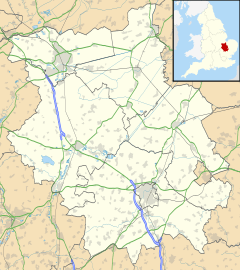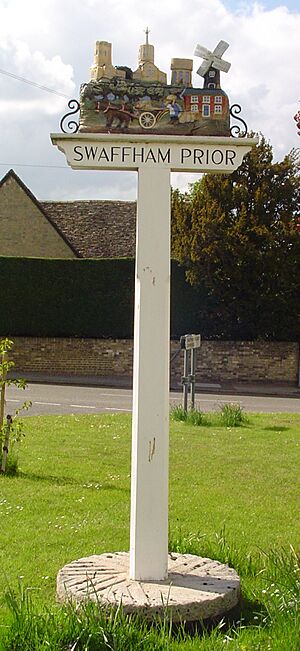Swaffham Prior facts for kids
Quick facts for kids Swaffham Prior |
|
|---|---|
 |
|
| Area | 7.62 sq mi (19.7 km2) |
| Population | 841 (2011Census) |
| • Density | 110/sq mi (42/km2) |
| OS grid reference | TL567639 |
| District |
|
| Shire county | |
| Region | |
| Country | England |
| Sovereign state | United Kingdom |
| Post town | CAMBRIDGE |
| Postcode district | CB25 |
| Dialling code | 01638 |
| EU Parliament | East of England |
Swaffham Prior is a small village located in East Cambridgeshire, England. It is about 5 miles west of Newmarket and 2 miles southwest of Burwell. People often refer to Swaffham Prior and its nearby village, Swaffham Bulbeck, as 'The Swaffhams'. In the past, Swaffham Prior was sometimes called Great Swaffham. It is important not to confuse it with the town of Swaffham in Norfolk.
This village is special because it was the first place in the United Kingdom to use a heating system for homes that covers a whole rural area. This system uses clean energy sources like solar panels and heat pumps. It stores heat underground and uses electric boilers. The heat travels through special pipes buried under the streets. Homes connected to this system can get heat for their radiators and hot water without needing new equipment. This big project cost £12 million. The government helped with a £3 million grant, and a local government loan also supported it. Residents pay for the heat through their household bills over many years.
Contents
Exploring Swaffham Prior's Unique Churches
Swaffham Prior is famous for its two churches that stand side-by-side. These churches have been part of the village for a very long time, since at least the 12th century. They are the Church of St Mary and the Church of St Cyriac and St Julitta. In 1667, a special law was passed that made both churches part of one parish.
The History of St Mary's Church
The Church of St Mary was first built during the Norman period. Over the years, it sometimes fell into disrepair. However, it was fully restored in the early 1900s and has been the main church for the village since 1903. Inside, you can see a beautiful screen called a rood screen. The church also has stained glass windows that show scenes from World War I.
The Story of St Cyriac and St Julitta Church
The original Church of St Cyriac and St Julitta (named after Cyriac and his mother, Julietta) was built before 1200. It might even have existed before 1066. The church you see today has a simple Gothic style. It has a small chancel (the area around the altar) and a nave (the main part where people sit), along with three small chapels. The tower was built in the 1400s and holds six bells. This church stopped being used for services for a while. In 1878, there was an order to tear it down, but that never happened. Now, it is used as a hall for art shows and other community events. The Scottish poet Edwin Muir (1887–1959) is buried here.
A Look at Swaffham Prior's Past
Swaffham Prior is a very old village. It is even mentioned in the Domesday Book from 1086. In that book, it might have been called 'Great Swaffham'. Just a mile north of the village, you can find an old Anglo-Saxon earthwork called the Devil's Dyke. This was a defensive wall built to block a land route through the fens.
Many houses in the village are centuries old, with some dating back to the 1600s. In the past, Swaffham Prior was a busy trading village. Today, it is more of a 'dormitory' village, meaning many people live there but travel to other places for work. The village has a primary school and a pub called The Red Lion. There is also a village hall where community events like feasts and fêtes are held.
Swaffham Prior is also known for its two windmills. One of them still works as a mill! These windmills are important symbols of the village and can be seen on the village sign on Cage Hill.
Understanding Swaffham Prior's Geography
The village of Swaffham Prior sits on a special type of landform called a chalk escarpment. An escarpment is a long, steep slope or cliff. This chalk escarpment, made of a local rock called clunch, runs through the entire village. It has been there since Anglo-saxon times.
The newer parts of the village are built along the top of this escarpment. The older houses are nestled below the cliff face, right behind the main street. This chalk escarpment creates a border between two different natural areas. To the west, the land slopes down into the Cambridgeshire Fens, which are low, marshy areas. To the east, the land rises into chalk heathland, known as Swaffham Prior heath. This heath is part of a larger area called the Greater Newmarket chalk heath.
You can only see parts of the escarpment in a few places, often on private land. A small section of it can be seen from the high street, across from the village play area.
How Many People Live in Swaffham Prior?
The number of people living in Swaffham Prior has changed over time. Sometimes, the village's population counts were combined with nearby places like Burwell and Reach due to changes in village borders. The table below shows the historical population of Swaffham Prior itself.
| Historical population of Swaffham Prior | |||||||||||
| Year | 1801 | 1811 | 1821 | 1831 | 1841 | 1851 | 1861 | 1871 | 1881 | 1891 | 1901 |
|---|---|---|---|---|---|---|---|---|---|---|---|
| Population | 925 | 1027 | 992 | 1017 | 813 | ||||||
| Year | 1911 | 1921 | 1931 | 1941 | 1951 | 1961 | 1971 | 1981 | 1991 | 2001 | 2011 |
| Population | 634 | 683 | 687 | 764 | 765 | 841 | |||||
| Census: 1801 – 2001 2011 | |||||||||||
See also
 In Spanish: Swaffham Prior para niños
In Spanish: Swaffham Prior para niños



